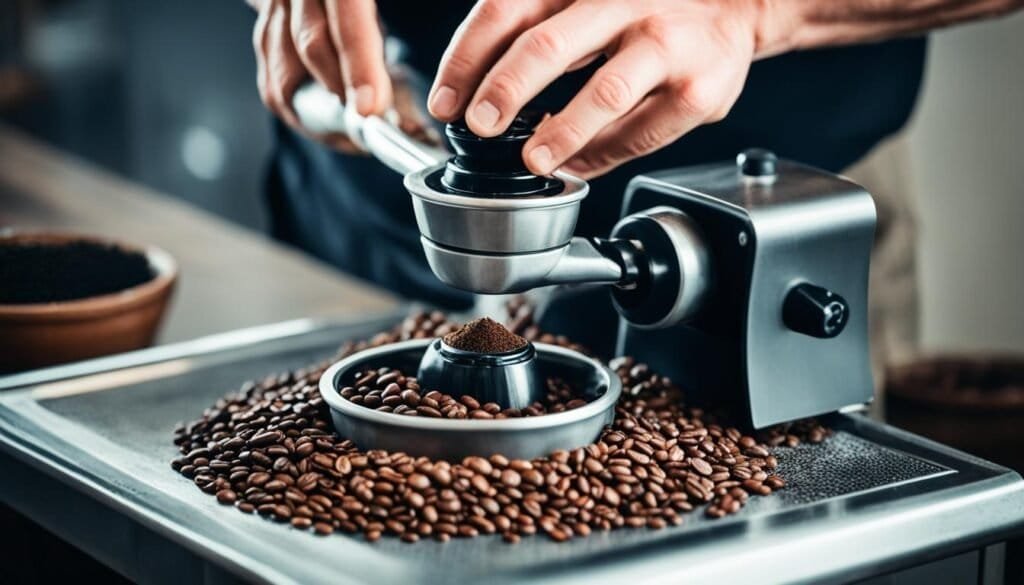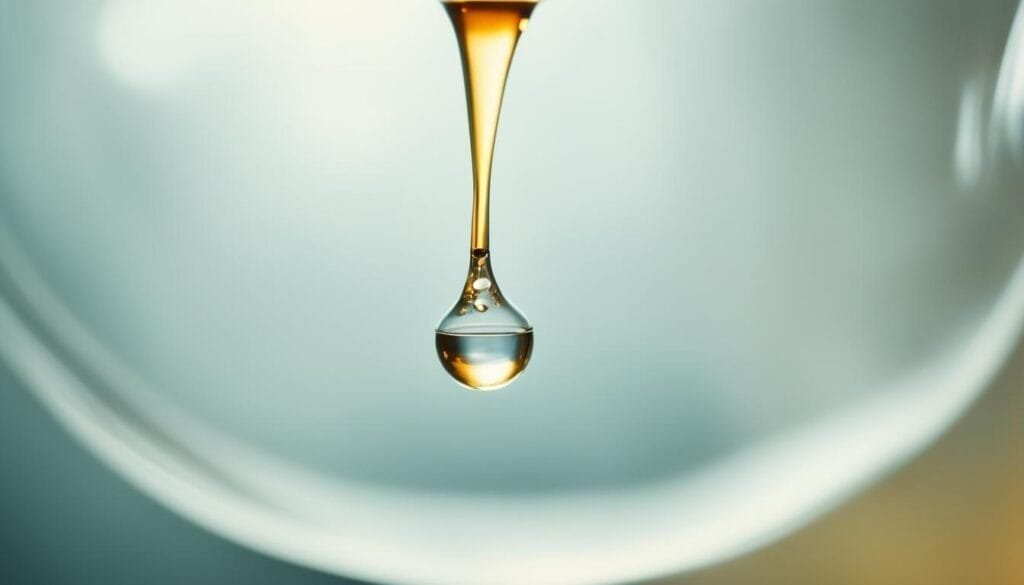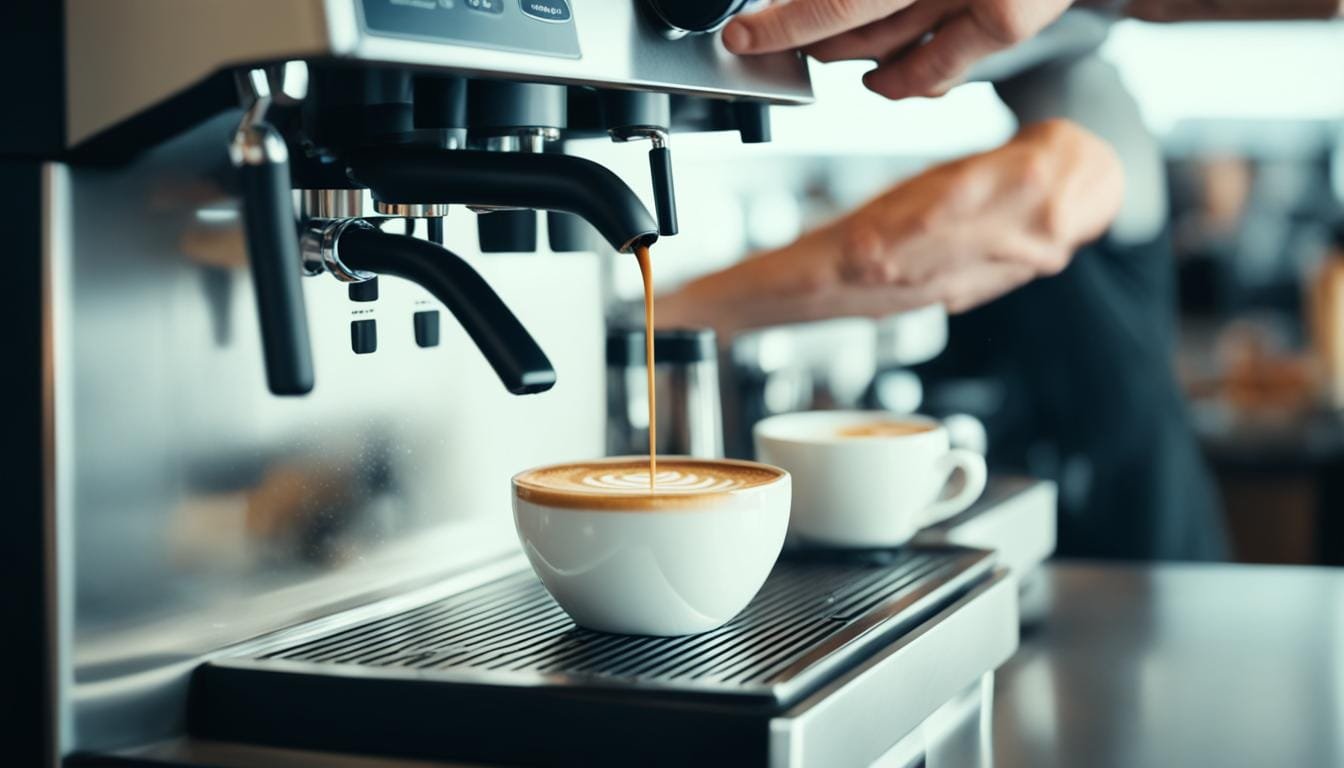Did you know that advanced espresso techniques can elevate your coffee-making skills to a whole new level? Whether you’re a barista in training or a passionate home brewer, delving into the world of advanced espresso making can unlock a myriad of flavors and aromas that will astound your taste buds. With expert espresso brewing tips and a deeper understanding of the intricate art of espresso, you can create barista-level coffee in the comfort of your own home.
As coffee lovers, we all crave that perfect cup of joe that leaves us feeling satisfied and energized. But it takes more than just pressing a button on your coffee machine to achieve coffee nirvana. By exploring advanced espresso techniques, you can master the art of brewing espresso like a true professional, unlocking the full potential of this rich and complex beverage.
Key Takeaways:
- Advanced espresso techniques can enhance the flavor and quality of your coffee.
- Understanding the basics of espresso brewing is essential for mastering advanced techniques.
- Choosing the right equipment, coffee beans, and water quality is key to consistency.
- Perfecting the art of tamping and understanding grind size are crucial for optimal extraction.
- With dedication and practice, you can become a master of advanced espresso making.
Understanding Espresso
Espresso is a concentrated form of coffee that is brewed through a unique and precise process. To truly appreciate this beloved beverage, it’s important to understand the basics of espresso making.
At its core, the espresso brewing process involves forcing pressurized hot water through finely ground coffee beans. This method extracts the aromatic oils and flavors from the beans, resulting in a rich and flavorful espresso shot.
The key elements that contribute to a great espresso shot include:
- Coffee Beans: The quality and freshness of the coffee beans play a vital role in the flavor profile of the espresso. Opt for freshly roasted beans from reputable roasters for the best results.
- Grind Size: The grind size of the coffee beans is crucial in determining the extraction time and flavor. This parameter should be finely tuned to ensure the ideal balance between sweetness, acidity, and body in the final cup.
- Water Temperature: The water temperature should be carefully controlled to maximize flavor extraction without scorching the coffee. The optimal range is typically between 195°F and 205°F (90°C to 96°C).
- Pressure: The brewing process relies on high pressure to extract the flavors efficiently. Commercial espresso machines typically use 9 bars of pressure, but home machines often have slightly lower pressure settings.
While a classic espresso shot is a true delight on its own, there are also various variations that espresso enthusiasts can enjoy. These variations include:
- Single Shot: A single espresso shot, typically served in a small cup, provides a concentrated burst of flavor.
- Double Shot: Double the pleasure with a double espresso shot, perfect for those who desire a stronger and more robust flavor.
- Ristretto: This Italian term refers to a shorter espresso shot made with less water for an intense and concentrated taste.
- Americano: For a milder and larger cup, an espresso shot is diluted with hot water to create an Americano.
- Cappuccino: A popular espresso-based drink made with equal parts espresso, steamed milk, and milk foam. It’s a perfect choice for those who enjoy a creamier texture.
Now that you have a better understanding of the espresso brewing process and its various variations, you can experiment with different beans, grind sizes, and brewing techniques to achieve the perfect cup of espresso.
“Espresso is a miracle of chemistry in a cup.” – Andrea Illy
| Espresso Variation | Description |
|---|---|
| Single Shot | A concentrated burst of flavor served in a small cup. |
| Double Shot | Double the pleasure with a stronger and more robust flavor. |
| Ristretto | A shorter espresso shot with less water for an intense taste. |
| Americano | An espresso shot diluted with hot water for a milder, larger cup. |
| Cappuccino | An espresso-based drink made with equal parts espresso, steamed milk, and milk foam. |
Types of Espresso Machines
When it comes to choosing the right espresso machine for your advanced espresso-making journey, understanding the different types available is essential. Each type offers unique features and benefits that cater to specific preferences and skill levels. Let’s explore the various types of espresso machines:
Semi-Automatic Espresso Machine
A semi-automatic espresso machine strikes a balance between control and convenience. With this type of machine, you have control over the grind size, tamping pressure, and extraction time. It requires manual input to start and stop the brewing process, allowing you to adjust variables during the espresso-making process based on your preferences. Semi-automatic machines are favored by coffee enthusiasts who enjoy hands-on brewing.
Automatic Espresso Machine
The automatic espresso machine takes convenience a step further. It handles the entire brewing process, from grinding the beans to extracting the espresso shot. You have control over the grind size and coffee dosage, but the machine takes care of tamping and extraction. With programmable settings, it’s easy to achieve consistent results. Automatic machines are popular among busy coffee lovers who seek a balance between convenience and customization.
Super-Automatic Espresso Machine
If you value simplicity and efficiency above all, a super-automatic espresso machine is the perfect choice. These machines handle everything from grinding to brewing with minimal user input. They often come equipped with programmable settings for various coffee specialties, including cappuccinos and lattes. Super-automatic machines offer a hassle-free brewing experience, making them ideal for those who want great espresso with minimal effort.
Lever Espresso Machine
If you appreciate the artistry and control of traditional espresso making, consider a lever espresso machine. These machines require manual operation and give you full control over the variables that influence the taste and extraction of your espresso. By manually pulling a lever, you control the pressure and duration of the extraction. Lever machines are a favorite among espresso purists and skilled baristas who enjoy the hands-on brewing process.
Pod Espresso Machine
For quick and convenient espresso brewing, pod espresso machines are an excellent choice. These machines use pre-packaged coffee pods or capsules, eliminating the need for grinding and measuring. Simply insert the pod, press a button, and enjoy a consistent and hassle-free espresso shot. Pod machines are perfect for those who prioritize speed and convenience without compromising taste.
Understanding the different types of espresso machines is crucial in selecting the one that aligns with your advanced espresso-making goals and preferences. Whether you crave hands-on control or prefer automated convenience, there’s a machine out there that will take your espresso-making journey to new heights.
Grinding Coffee Beans
When it comes to making great espresso, the grind size and consistency of the coffee beans play a critical role. Choosing the right beans and achieving the perfect grind can significantly impact the flavor and extraction of your espresso shots.
When selecting coffee beans for espresso, opt for those specifically labeled as suitable for espresso brewing. These beans are typically crafted to withstand the brewing process and deliver the desired taste and aroma. Look for beans that are freshly roasted to ensure optimal quality.
Grind size is another vital element to consider. For espresso, a fine grind is recommended to maximize surface area contact with the water during extraction. The smaller the grind particles, the faster and more efficiently the flavors are extracted. Aim for a grind size resembling fine sand for best results.
Consistency in grind size is equally crucial. Unevenly ground coffee can result in an uneven extraction, leading to a subpar espresso experience. Use a high-quality burr grinder to ensure a consistent grind size. Avoid blade grinders as they tend to produce inconsistent particle sizes, which can negatively impact the extraction process.
“The grind size and consistency of the coffee beans greatly impact the flavor and extraction of your espresso shots.”
To achieve consistent results, it is essential to invest in a reliable burr grinder that allows you to adjust the grind size according to your preferences. Experiment with different grind sizes and observe how they affect the taste and quality of your espresso shots. Remember, it’s all about finding the right balance to unlock the full potential of your chosen coffee beans.
Choosing the right coffee beans:
- Look for beans specifically labeled for espresso brewing
- Opt for freshly roasted beans for optimal flavor
Grind size recommendations:
- Aim for a fine grind size resembling fine sand
- Use a high-quality burr grinder for consistent results

Mastering the art of grinding coffee beans for espresso is an essential step towards achieving the perfect cup. By selecting the right beans and ensuring a consistent grind size, you’ll enhance the flavor, aroma, and overall espresso experience.
Water Quality and Temperature
In the world of espresso making, water quality and temperature play a crucial role in achieving the perfect cup. Understanding the importance of these factors will help you elevate your brewing game. Let’s delve into why water quality and temperature matter in the pursuit of exceptional espresso.
Importance of Water Quality
Using clean, filtered water is essential for brewing high-quality espresso. Water that is free from impurities such as chlorine, minerals, and other contaminants ensures a pure and unadulterated flavor profile. Impurities in water can taint the taste of your espresso, resulting in a subpar experience. To preserve the integrity of the coffee’s flavors, invest in a reliable water filtration system that removes any unwanted particles.
Ideal Water Temperature
The ideal water temperature for brewing espresso falls within the range of 195 to 205 degrees Fahrenheit (90 to 96 degrees Celsius). This temperature range allows for optimal extraction of the coffee’s oils, flavors, and aromas, resulting in a balanced and flavorful shot. Brewing at temperatures outside this range may lead to under-extraction or over-extraction, resulting in sour or bitter-tasting espresso.
When brewing espresso, it’s crucial to maintain consistent water temperature throughout the brewing process. Fluctuations in temperature can significantly affect extraction and the overall quality of your brew. Investing in an espresso machine with precise temperature control mechanisms will help ensure consistent results.
| Water Quality | Ideal Temperature Range |
|---|---|
| Clean, filtered water | 195-205°F (90-96°C) |
By paying attention to water quality and temperature, you can unleash the full potential of your espresso beans and create a delightful sensory experience with each sip. Remember, the journey to mastering advanced espresso making lies in understanding and optimizing every element of the brewing process, including the often overlooked but critical factors of water quality and temperature.

Mastering the Art of Tamping
Tamping is a critical and often underestimated step in the process of creating the perfect espresso shot. It involves applying the right amount of pressure to compact the coffee grounds evenly before brewing. Mastering the art of tamping is essential for achieving optimal extraction and flavor in your espresso.
One crucial factor to consider when tamping is the ideal tamping pressure. Applying too much pressure can result in over-extraction, leading to a bitter and unpleasant taste. On the other hand, not applying enough pressure can cause under-extraction, resulting in a weak and watery espresso.
Choosing the right tamper is equally important. The size and weight of the tamper should complement your espresso machine and fit comfortably in your hand. Look for a tamper with a flat and level base that matches the size of your portafilter.
The grind size for tamping is another essential aspect to consider. For espresso, a fine and consistent grind is necessary to ensure even extraction. Experiment with different grind sizes to find the sweet spot that suits your taste preferences.
Proper tamping technique plays a significant role in achieving a dense and evenly distributed coffee puck. Begin by distributing your coffee grounds evenly in the portafilter. Place the tamper on top of the grounds and apply firm and even pressure, using your wrist rather than your arm to avoid excessive force. The tamper should be held perpendicular to the portafilter, applying pressure in a downward and slightly twisting motion.
By mastering the art of tamping and understanding the importance of tamping pressure, choosing the right tamper, grind size for tamping, and utilizing proper tamping technique, you can elevate your espresso-making skills to new heights. Achieve consistent and flavorful espresso shots that will impress even the most discerning coffee lovers.
Conclusion
Mastering the art of advanced espresso making is a rewarding journey that requires a firm grasp of the basics, the right equipment and coffee beans, as well as impeccable techniques. By understanding the intricacies of espresso brewing, selecting the ideal equipment, and implementing proper techniques like tamping and water management, you can elevate your coffee-making skills to new heights.
With this professional espresso making guide, you have learned the importance of grind size, water quality, and temperature in achieving the perfect espresso shot. Remember to choose high-quality coffee beans and grind them to precision, ensuring consistency and optimal extraction. Pay close attention to water quality, as filtered water plays a crucial role in the overall flavor profile of your espresso.
Additionally, perfecting the art of tamping is essential for obtaining an even extraction. Proper tamping pressure, using the right tamper, and selecting the appropriate grind size all contribute to a dense puck that allows for a balanced and flavorful cup of espresso.
By following these techniques for perfect espresso making, you can impress yourself and others with barista-level espresso creations. Take pride in your newfound expertise and enjoy the rich, aromatic indulgence of a perfectly brewed cup of espresso in the comfort of your own home.
FAQ
What is espresso?
Espresso is a concentrated form of coffee brewed by forcing pressurized hot water through finely ground coffee beans.
What factors are important in the espresso brewing process?
The espresso brewing process involves important factors such as coffee beans, grind size, water temperature, and pressure.
What are the different types of espresso machines available?
There are different types of espresso machines available, including semi-automatic, automatic, super-automatic, lever, and pod machines.
Why is the grind size and consistency of coffee beans important for making espresso?
The grind size and consistency of coffee beans greatly impact the flavor and extraction of espresso shots.
Why is water quality and temperature important in brewing espresso?
Water quality and temperature play a crucial role in achieving a great cup of espresso, affecting the taste and extraction.
What are the key factors to consider for proper tamping?
Proper tamping involves considering factors such as tamping pressure, choosing the right tamper, grind size for tamping, and tamping technique.




